Anyone fascinated by Southeast Asian history will love Sukhothai. The city represents Thailand’s golden age and was the seat of power for the nation’s greatest leaders notably King Ramkhamhaeng the Great (1239-1298).
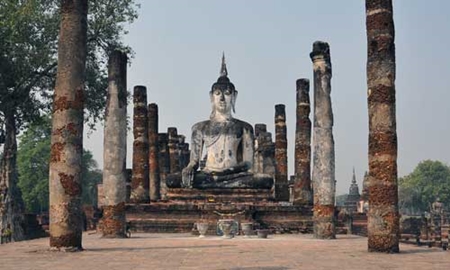
The Buddha images of Sukhothai were designed to evoke serenity.
During the Sukhothai era, the Thai alphabet was formulated, the foundations for Thailand’s politics and culture were established, and Theravada Buddhism became the national religion. This was a golden age when according to a famous 1292 inscription there was always “Fish in the water and rice in the fields.”
Now the ruins and temples are a UNESCO World Heritage Site but still venerated by people coming to pay respect and celebrate festivals like Loi Krathong. No wonder the city retains its place in the hearts of the Thai people. But for visitors looking to explore, there is a less obvious attraction – the ancient city of Sukhothai is wonderfully, blissfully flat.
“Flatness?” you may ask. “What sort of value does that add to the tourist experience?” Well basically it makes Sukhothai Historical Park the best place in Thailand to see by bicycle. Sitting in a valley plain, there are no hills within the park and even out-of-shape travellers find it easy to cycle between the monuments at a stately pace with minimum effort. Trees provide shade and there are stalls for refreshments. It really is the best way to get around.
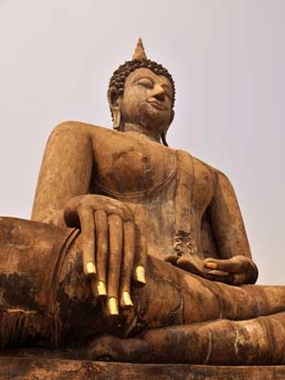
One of the most popular of the Wat Mahathat Buddha’s becuause of its golden fingernails.
But before you mount a bike, visit the Ramkhamhaeng National Museum (09.30-16.00 hrs.) by the main Kampaeng Hak Gate. Here you can get a good overview of the city’s history and see some of the artefacts collected by archaeologists over the years.
When you need your wheels, there are bike rental shops near to the Park’s entrance. Be warned, many of the boneshakers available seem to date from the era of King Ramkhamhaeng the Great himself – they’ve certainly seen better days. But you can’t fault the price – only 30-40 Baht daybreak till around 19.00 hrs.
If you’re carrying camera equipment and bags, ask the rental shop owners for some bungee ropes to secure your stuff. The gentle roads, antiquated transport and traffic-free nature of the Park means you can forgo a cycle helmet, but you do need protective headgear in the form of a sun hat – and take sunscreen – it gets hot out there.
Once you’ve mastered your battered bike and nervously peddled to the Park’s entrance, you need a ticket. Unfortunately, you can no longer get one general ticket, rather you have to decide what areas of the Park you plan to see (at around 100 Baht a pop and 10 Baht for the bike). There are ticket offices at all entrances, so you can make your mind up as you go along.
If you’re short of time; or are a templed-out by Thailand (it does happen), then stay within the city walls. The main attraction is the principal temple of the Sukhothai Period, Wat Mahathat. Many of the famous Sukhothai Buddha statues, in standing as well as sitting poses are here.
These make for great photos but remember they are objects of veneration for Buddhists, so be mindful and respect them as you would images in any other temple. The other main feature of Wat Mahathat is the large lotus-bud chedi – but there are 200 other pagodas around as well as exquisitely carved stonework.
A couple of hundred metres from Wat Mahathat is a smaller but more elaborate temple, Wat Si Sawai which will seem familiar to anyone who’s visited India. For the temple’s three carved stupas evoke Hindu architecture, indeed it was thought once to have been a Hindu shrine and sharp-eyed visitors will spot Vishnu hidden in the stucco relief, as well as more familiar Southeast Asian imagery; such as, the mighty Naga.
North of Wat Mahathat, on its own island is Wat Sa Si. Leave your bikes at the entrance and approach by bridge. The most distinctive feature is the bell-shaped chedi – the Ceylonese style of which shows the influence of Sri Lankan Buddhism in Sukhothai. Wat Sa Si is the venue for the Tourism Authority of Thailand’s (TAT) monthly mini-light and sound shows (Sukhothai staging this year’s mini-light and sound shows between February and September) and it’s worth trying to time your trip, so you can see the show and watch the history of the city brought to life.
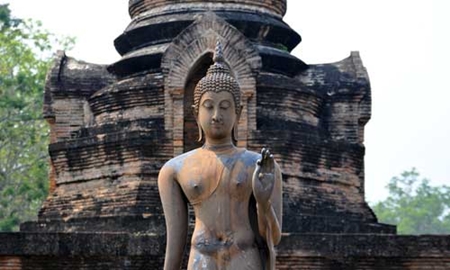
Wat Sa Si’s graceful standing Buddha shows the skill of the Sukhothai sculptors
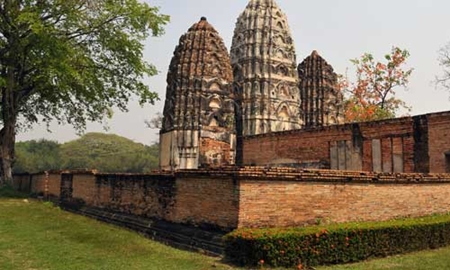
The corn shaped stuptas of Wat Si Sawai evoke a Hindu temple.
Behind Wat Sa Si is the famous statue of King Ramkhamhaeng the Great. The king is seated in a teaching pose and his face is styled after the image of the Buddha. Though relatively new, the statue is worth stopping for. After all, without this influential monarch, the name of Sukhothai could well be forgotten – a mere footnote in history.
If you’ve the time, you’ll find some of the most interesting sights of Sukhothai lie beyond the city walls. Kids love Wat Chang Rop with its massive elephant heads near the east gate. But there are greater treasures further west. Take the Tak road, take a right into the western zone and you find forest temples, hermitages and chedis sitting like an arboreal Atlantis among the greenery – you need a separate ticket but it’s worth it.
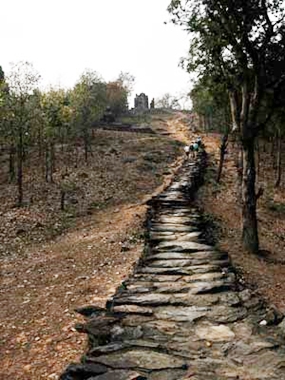
It’s a steep climb up to Wat Saphan Hin in the western zone of the park
The main attraction here is Wat Saphan Hin which sits atop a 200-metre high hill. You can’t cycle up the rough stone pathway and it’s a tiring trek to the top, but the view over the old city is almost worth it. Here there’s a 12-metre high standing Buddha. According to legend, King Ramkhamhaeng the Great would ride his white elephant to this temple at full moon to pay his respects. But it must have been an elephant with stronger knees than this writer. The climb takes it out of you, so bring a spare bottle of water. Luckily, it’s an easy ride back to the main city on pleasant roads.
This can only be a taster. There are so many temples and ruins within the historical park that you are going to need more than a day to see them all, and a longer article than this one to describe them. But rent a bike, see the main sites and you are off to a great start. The major attractions can be seen over the course of a long day and by cycling you get to see it all at a sedate pace and feel you’ve earned a sundown beer. – just get on your bike and get out there.
Sukhothai Historical Park is located 439.7 km north of Bangkok; about four-five hours by car or 1 hour 15 minutes by air.
For high-resolution images, please click to visit the TAT Newsroom Photo Library
Wat Mahathat
Wat Si Sawai
Wat Sa Si
Wat Saphan Hin
Republishing permission (click to read disclaimer)
Filed in : Features
Tags: Latestupdate




